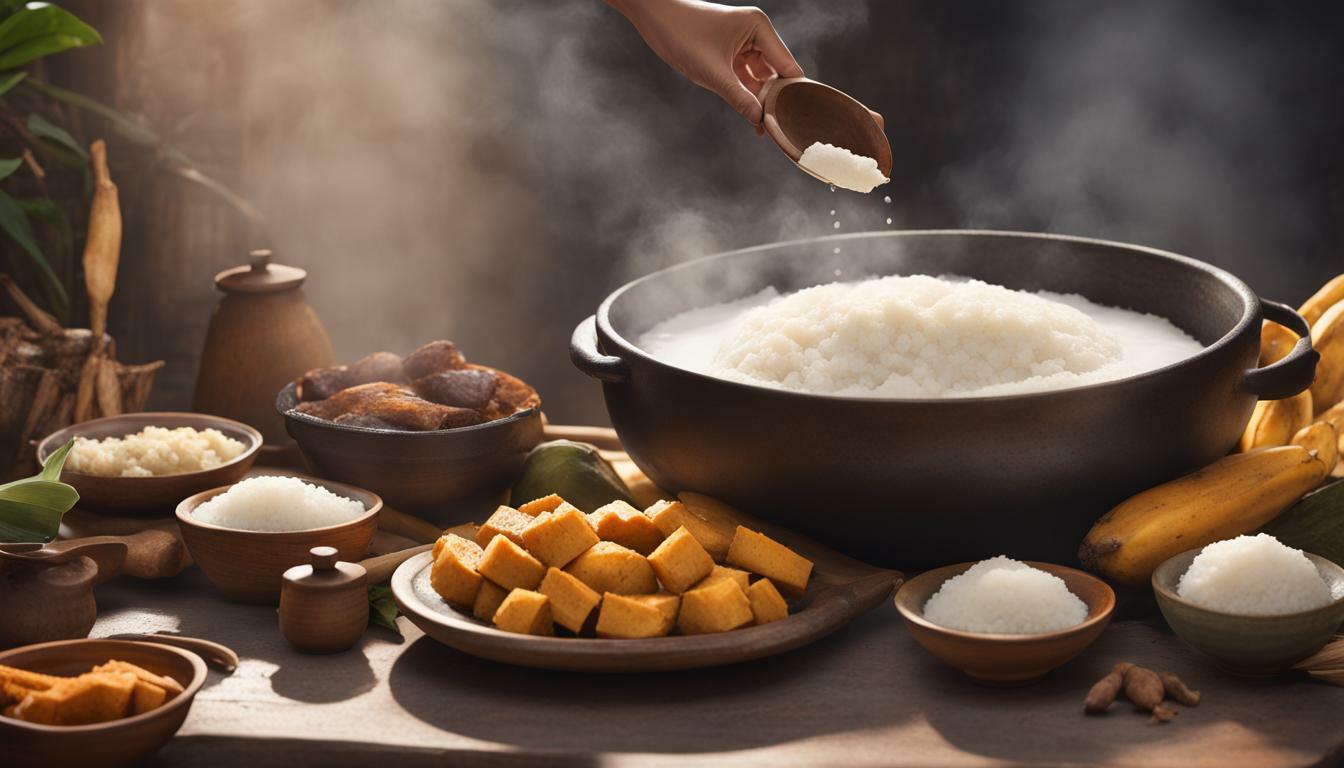📖 Article Content 📖
Fufu, that wonderful, pliable dough, is a central part of so many delicious meals, and sometimes, you might find yourself with a little bit extra, which is actually quite nice, you know, because it means another chance to savor it. But how do you warm it up again without losing that pleasing chewiness or having it turn into something hard or rubbery? It's a question many folks ask, and getting it right can mean the difference between a truly satisfying second helping and a less than ideal experience, so, we are here to help.
Most people, as a matter of fact, might just grab the microwave, thinking it is the quickest way to get their food warm, and for some things, that works just fine, but for something like fufu, which has a very particular feel and consistency, a quick zap might not be the best approach if you want it to taste like it just came from the pot. We want that delightful texture to come back, the way it was when it was first made, and that, in a way, needs a little bit of care.
There are, you know, some really good ways to bring your fufu back to life, whether it is a small piece or a larger portion, and we will walk through the ways to do this, giving you some helpful ideas to make sure your fufu is just as good, if not better, the next time you enjoy it, pretty much ensuring every bite is a pleasure.
- Im Looking For A Man In Finance Original
- G In Bubble Letters
- Kim Kardashian Transitioning
- Feet Worship Dont Mf Snitch 2
- Jenna Talia Meaning
Table of Contents
- Why Does Reheating Fufu Matter So Much?
- Is the Microwave the Best Way to Reheat Fufu?
- How to Reheat Fufu Using Gentle Heat?
- How to Reheat Fufu in the Oven?
- Reheating Fufu on the Stovetop - A Steamy Approach
- Reheating Fufu in the Microwave - Quick, But Be Careful
- Tips to Keep Your Reheated Fufu From Drying Out
- When to Reheat Fufu - What About Safety?
Why Does Reheating Fufu Matter So Much?
You might be wondering why we are even talking about warming up fufu again, you know, when it seems like a simple enough thing to do. Well, fufu, being what it is, a kind of dough made from starchy plants, has a very special feel to it when it is fresh. It is soft, pliable, and just a little bit stretchy, perfect for scooping up your favorite stew or soup. When it gets cold, though, it can get a bit stiff, or even hard, which changes the whole eating experience, basically.
The trick, then, is to bring back that lovely softness without making it mushy or too dry, or having it turn into a rubbery lump. That is why the way you warm it up again really does make a difference. If you just blast it with heat, you could end up with parts that are hard as a rock and other parts that are, you know, kind of soggy. So, to keep that wonderful taste and feel, picking the right way to warm it up is pretty important, honestly, because nobody wants a less than great fufu experience, right?
It is all about keeping that wonderful texture that makes fufu so special. When you make it fresh, it has a certain give, a pleasant chewiness that is so satisfying. Losing that when you warm it up again would be a shame, wouldn't it? So, by taking a little bit of extra thought about how to reheat fufu, you can make sure that your second meal is just as enjoyable as the first, or very nearly, anyway.
Is the Microwave the Best Way to Reheat Fufu?
For many kinds of extra food, the microwave is often the first thing people think of, just because it is so fast, you know? You put your plate in, press a few buttons, and in a minute or two, your food is warm. And for some things, like a simple bowl of rice or some soup, that quick zap works out just fine. But when it comes to fufu, which has a very particular make-up, the microwave might not be the top choice if you are aiming for the best possible taste and feel.
The thing about microwaves is that they heat food very quickly, and sometimes unevenly, by making the water inside the food move around very fast. For fufu, this can mean that parts of it get really hot and hard, while other parts might still be cool, or even turn a bit rubbery. It is like trying to make something soft and delicate feel good again with a sudden burst of energy, which, you know, does not always go as planned. So, if your goal is to have your fufu taste as fresh as it did the day before, or very close to it, you might want to look at other ways to warm it up again.
Many folks find that food warmed up again in a microwave just does not quite hit the mark compared to how it tasted fresh. This is especially true for items that rely on a certain texture, like fufu. While it is quick, and can certainly warm up your fufu, it might not bring back that soft, pliable feel that you really want. So, if you are asking "how to reheat fufu and make it truly good?", the microwave, honestly, is probably not the very best answer for quality, though it is quick.
How to Reheat Fufu Using Gentle Heat?
When you are thinking about how to reheat fufu, one of the kindest ways to do it is with a gentle sort of warmth. This means avoiding sudden, very hot blasts of heat that can make your fufu tough or dry out its nice, soft inside. Instead, we are looking for a way to slowly bring it back to a good temperature, allowing its original feel to return without any harsh changes, which is, you know, pretty important for this type of food.
Think about how fufu is made; it often involves cooking in water or with steam, which gives it that smooth, pliable body. So, when you warm it up again, trying to copy that gentle, moist heat can work wonders. This approach helps to keep the water content in the fufu balanced, preventing it from becoming hard on the outside or too dry inside, which is, honestly, a common problem with some warming methods, especially for something like this, so.
Using gentle heat also gives you more control over the warming process. You can check on your fufu more often, feeling it to see if it is getting back to that lovely soft state you want. This patient way of doing things means you are much more likely to end up with fufu that feels just as good as it did when it was first prepared, or very nearly, and that is what we are aiming for, as a matter of fact, when we talk about how to reheat fufu in a good way.
How to Reheat Fufu in the Oven?
If you are looking for a way to warm up your fufu that really brings back its original feel and taste, the oven is often a really good choice, honestly. It is a bit like how you would warm up a nice piece of meat, say, some ribs, where you want them to get warm all the way through without drying out or getting too hard on the outside. The oven gives you a more even kind of warmth that can slowly make your fufu soft and pliable again, which is very nice.
To warm up your fufu in the oven, you will want to set your oven to a fairly low heat, something around 275 to 300 degrees Fahrenheit (about 135 to 150 degrees Celsius). This lower warmth level helps to warm the fufu slowly from the outside in, without zapping it too quickly. You should place your fufu in an oven-safe dish, and this is pretty important, you know, you should add a tiny bit of water or broth to the bottom of the dish, or cover the fufu loosely with foil. This helps to create a steamy little space around the fufu, keeping it from drying out, which is a common concern when you reheat fufu.
Let the fufu warm up for about 15 to 25 minutes, depending on how big your piece is. You will want to check on it now and then to see how it is doing. It should feel soft and warm all the way through when it is ready. This method really helps to bring back that smooth, pleasing feel that fufu should have, making it a much better experience than a quick zap in the microwave, so, if you have the time, this is often the way to go for how to reheat fufu with good results.
Reheating Fufu on the Stovetop - A Steamy Approach
Another excellent way to warm up your fufu, especially if you want to make sure it stays nice and soft, is to use your stovetop. This method is a bit like steaming, and it is really good for bringing back that fresh, pliable feel without drying out the fufu at all. It is a gentle way to introduce warmth, making it a very kind approach to how to reheat fufu, you know, keeping its best qualities.
For this way of doing things, you will need a pot with a lid and a little bit of water. You can put your fufu directly into a pot with a tiny splash of water at the bottom, just enough to create some steam, but not so much that the fufu sits in it. Or, a clever way to do it is to put your fufu in a heat-safe bowl, and then place that bowl inside a larger pot that has a small amount of water in the bottom, making sure the water does not touch the fufu directly. Then, put the lid on the larger pot.
Turn your stove to a low to medium heat, allowing the water to gently steam. The steam will then warm the fufu slowly and evenly, giving it back its soft texture. This might take anywhere from 10 to 20 minutes, depending on the size of your fufu piece. You will want to check it every so often to make sure it is warming through and becoming soft again. This stovetop method is particularly good for how to reheat fufu if it was a bit hard from the fridge, as the steam really helps to make it yielding once more, basically, a very effective way to get it just right.
Reheating Fufu in the Microwave - Quick, But Be Careful
While we have talked about how the microwave might not be the top choice for the very best fufu experience, it is, as a matter of fact, very quick, and sometimes, quick is what you need. If you are in a hurry and just want to warm up your fufu without a lot of fuss, the microwave can do the job, but there are some things you should do to make it as good as it can be, even with this speedy method. It is all about trying to keep that nice feel when you reheat fufu with a quick zap.
To warm up fufu in the microwave, first, put your fufu on a microwave-safe plate. This next step is pretty important: add a tiny bit of water to the fufu itself, maybe just a teaspoon or two, and then cover the plate. You can use a microwave-safe lid or even a piece of plastic wrap, making sure to leave a little gap for steam to get out. The added water and covering help to create some steam, which is very helpful in stopping the fufu from getting too hard or rubbery, which can happen very easily in the microwave, you know.
Warm the fufu for short bursts of time, like 30 seconds to a minute, then take it out, turn it over, and maybe even knead it a little bit with a spoon or your hand (if it is cool enough to touch). Then, put it back in for another short burst. Keep doing this until it is warm all the way through and feels soft again. This stop-and-go method, and the added moisture, helps to warm the fufu more evenly and reduces the chance of those hard, chewy spots. So, while it is not the ideal way, it is a workable one for how to reheat fufu quickly, if you are careful.
Tips to Keep Your Reheated Fufu From Drying Out
One of the biggest worries when you are warming up fufu again is that it will get all hard and dry. Fufu, by its very nature, needs a good amount of moisture to stay soft and pliable, so when it gets cold and then warm again, it can lose that moisture if you are not careful. But there are some good ideas to help you keep your fufu feeling just right, pretty much as it was when it was first made, when you reheat fufu.
The main idea is to add moisture and keep it trapped around the fufu while it is warming. This is why covering your fufu is such a good move, no matter which warming method you pick. Whether it is with a lid on a pot, aluminum foil in the oven, or plastic wrap in the microwave, covering it helps to create a steamy little world around your fufu. This steam helps to reintroduce moisture and keeps the fufu from losing its own water content to the dry air, which is a common problem, honestly.
Also, adding a little bit of liquid, like a splash of water or some soup broth, can make a real difference. For oven warming, putting a little liquid in the bottom of the dish works well. For stovetop warming, the steam from the water in the pot does the job. And for the microwave, a few drops of water directly on the fufu before covering it can work wonders. These small actions go a long way in making sure your fufu stays wonderfully soft and does not turn into a hard, unyielding mass when you reheat fufu, so, remember these little touches.
When to Reheat Fufu - What About Safety?
When you are thinking about warming up any extra food, including fufu, it is always a good idea to keep food safety in mind. You want to make sure your food is safe to eat, of course, and that means warming it up correctly and making sure it has been kept in a good way before you even start the warming process. It is just good sense, you know, to be careful with what you eat, especially when you reheat fufu.
First off, if your fufu has been sitting out at room temperature for more than a couple of hours, it is probably best not to warm it up again. Food that has been left out too long can grow things that are not good for you, even if you warm it up later. So, always make sure your fufu has been kept in the fridge as soon as it cooled down after its first meal. This helps to keep it safe for later enjoyment, which is pretty important.
When you do warm it up, make sure it gets hot all the way through. It should be steaming hot, not just a little bit warm in the middle. If your fufu was frozen, it is perfectly fine to warm it up from a partially soft state, but just remember that it will take a bit longer to get it hot all the way through if it is still a little bit frozen. So, give it enough time and check that it is fully warm before you enjoy it, just to be on the safe side, as a matter of fact, when you reheat fufu.
So, there you have it, some good ways to warm up your fufu again, making sure it stays soft and pleasing. We have talked about how the oven can bring back that lovely feel with gentle warmth, and how the stovetop can steam your fufu back to its best self. Even the microwave, with a few clever steps, can do the job if you are in a rush. The main thing is to add moisture and keep it covered, stopping that fufu from getting dry. And remember to always keep your fufu cool in the fridge until you are ready to warm it up, making sure it is safe to eat. By following these ideas, you can look forward to enjoying your fufu again, almost as good as the first time.



